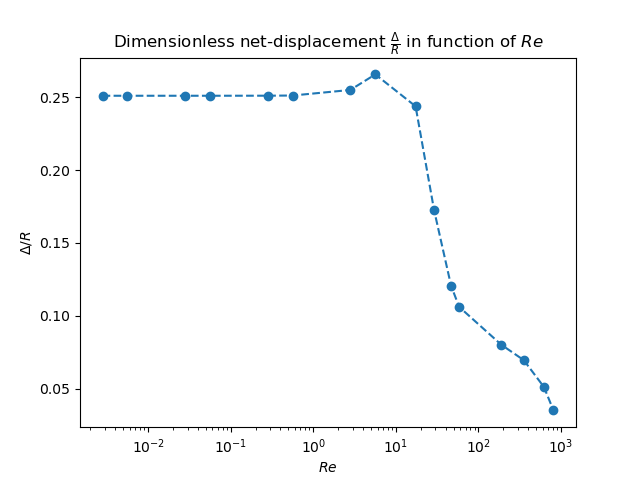Three Sphere Swimmer & Low Reynolds Number \(Re\)
1. Introduction
Here, using the Navier-Stokes equation, we check the dependence of the net-displacement of the three-sphere swimmer with the Reynolds number \(Re\).
2. Reynolds number \(Re\)
We use the Navier-Stokes equation with low Reynolds number given by : \[ Re = \frac{\rho UL}{\mu},\] where :
-
\(U\) : the velocity of the swimmer
-
\(\rho\) : the fluid density
-
\(L\) : the swimmer’s length
-
\(\mu\) : the fluid vescosity.
In our example, the viscosity and the density of the fluid are fixed, so the Reynolds number depends on the swimmer’s length and velocity. As we aim to perform many simulations for different values of \(Re\), we change the arm’s length of the swimmer \(D\), and for each simulation, we fix the relative velocity of the swimmer to be \(U = 4R\), where \(R\) is the spheres radius (Note that \(D=10R\)).
3. 2D-Three sphere swimmer
We study the 2D-three sphere swimmer studied before with the Stokes equation in 3SS with Navier-Stokes. Note that it was also studied using the Stokes equation in 3-spheres-2D.
We remind that the swimmer consists of three spheres of radius \(R\) linked by two rigid arms of length \(D\).
4. Geometry
The swimmer mensionned above is placed at the center of a rectangular channel of dimensions \([-L, L]\times[-l, l]\). See 3-spheres-2D.
5. Inpute parameters
The simulations performed for different values of \(D\) in \([5.10^{-7}, 10^{-1}]\). For each simulation, here are the parameters we used (that obviously depend on \(D\)):
Name |
Description |
values |
Unit |
\(R\) |
spheres radius |
\(\frac{D}{10}\) |
\(m\) |
\(U\) |
relative velocity |
4 \(\frac{D}{10}\) |
\(ms^{-1}\) |
\(L\) |
length of the channel |
5 \(D\) |
\(m\) |
\(l\) |
width of the channel |
2 \(D\) |
\(m\) |
6. Materials
Name |
Description |
values |
Unit |
\(\rho_{fluid}\) |
fluid density |
1.025\(\times 10^{-3}\) |
\(kg/m^3\) |
\(\rho_{spheres}\) |
spheres density |
1.025\(\times 10^{-3}\) |
\(kg/m^3\) |
\(\mu\) |
fluid viscosity |
\(10^{-3}\) |
\(N.s/m^2\) |
7. Results
For the simulations we performed, we show in the figures below, the relation between the Reynolds number \(Re\) and the dimensionless net-displacement of the swimmer.


The first figure shows the dimensionless net-displacement \(\frac{\Delta}{R}\) in function of the Reynolds number \(Re\) that depends on \(D\) for each simulation.
The second figure presents the same graph with a logarithmic scale in the \(x\)-axis for a better visualization of low values in \(10^{-3}, 10^2\).
Now we check the \(Y\)-net displacement of the swimmer for different low Reynolds number. The figure below presents the dimensionless \(Y\)-net displacement after one period for some values of \(Re\) mentioned in the figure.

References on Swimming
-
[Najafi_2004] Ali Najafi, Ramin Golestanian. Simple swimmer at low Reynolds number: Three linked spheres. 2004. American Physical Society. doi.org/10.1103/PhysRevE.69.062901 linkDownload PDF
-
[nature] Jikeli, J., Alvarez, L., Friedrich, B. et al. Sperm navigation along helical paths in 3D chemoattractant landscapes. Nat Commun 6, 7985 (2015). doi.org/10.1038/ncomms8985 Download PDF
-
[bgp_cemracs_2019] Luca Berti, Laetitia Giraldi, Christophe Prud’Homme. Swimming at Low Reynolds Number. ESAIM: Proceedings and Surveys, EDP Sciences, 2019, pp.1 - 10, doi.org/10.1051/proc/202067004 Download PDF
-
[bcgp_three_spheres_2020] Luca Berti, Vincent Chabannes, Laetitia Giraldi, Christophe Prud’Homme. Modeling and finite element simulation of multi-sphere swimmers. 2020. hal-mines-paristech.archives-ouvertes.fr/ENSMP_CEMEF/hal-03023318v1 Download PDF
-
[gbcc_epje_2017] K. Gustavsson, L. Biferale, A. Celani, S. Colabrese Finding Efficient Swimming Strategies in a Three Dimensional Chaotic Flow by Reinforcement Learning Published on Eur. Phys. J. E (December 14, 2017) 10.1140/epje/i2017-11602-9 Download PDF
-
[purcell_1977] E.M. Purcell. Life at Low Reynolds Number, American Journal of Physics vol 45, p. 3-11 (1977). doi.org/10.1119/1.10903 Download PDF
 .pdf
.pdf